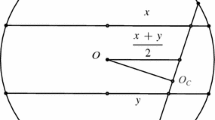Abstract
A fundamental result of sub-Riemannian geometry, the ball-box theorem, states that small sub-Riemannian balls look like boxes \([ - \varepsilon ^{\omega _1 } ,\varepsilon ^{\omega _1 } ]\) × ··· × \([ - \varepsilon ^{\omega _n } ,\varepsilon ^{\omega _n } ]\) in privileged coordinates. This description is not uniform in general. Thus, it does allow us neither to compute Hausdorff measures and dimensions nor to prove the convergence of certain motion planning algorithms.
In this paper, we present a description of the shape of small sub-Riemannian balls depending uniformly on their center and their radius. This result is a generalization of the ball-box theorem. The proof is based on the one hand on a lifting method, which replaces the sub-Riemannian manifold by an extended equiregular one (where the ball-box theorem is uniform); and on the other hand, it based on an estimate of sets defined by families of vector fields, which allows us to project the balls in suitable coordinates.
Similar content being viewed by others
References
R. Abraham and J. E. Marsden, Foundations of mechanics. Addison-Wesley, 1978.
A. A. Agrachev, R. V. Gamkrelidze, and A. V. Sarychev, Local invariants of smooth control systems. Acta Appl. Math. 14 (1989), 191–237.
A. A. Agrachev and A. V. Sarychev, Filtrations of a Lie algebra of vector fields and nilpotent approximations of control systems. Dokl. Akad. Nauk SSSR 285 (1987), 777–781. English translation: Soviet Math. Dokl. 36 (1988), 104–108.
A. Bellaïche, The tangent space in sub-Riemannian geometry. In: Sub-Riemannian Geometry, Progress in Mathematics (A. Bellaïche and J.-J. Risler, Eds.), Birkhäuser, 1996.
N. Bourbaki, Groupes et Algèbres de Lie. Hermann, Paris, 1972.
W. L. Chow, Über Systeme von linearen partiellen Differentialgleichungen erster Ordnung. Math. Ann. 117 (1940), 98–115.
C. Godbillon, Géométrie Différentielle et Mécanique Analytique. Hermann, Paris, 1969.
N. Goodman, Nilpotent Lie groups. In: Lecture Notes in Math. Vol. 562, Springer Verlag, 1976.
M. Gromov, Carnot-Carathéodory spaces seen from within. In: Sub-Riemannian Geometry, Progress in Mathematics (A. Bellaïche and J.-J. Risler, Eds.), Birkhäuser, 1996.
H. Hermes, Nilpotent and high-order approximations of vector field systems. SIAM Rev. 33 (1991), No. 2, 238–264.
F. Jean Entropy and complexity of a path in sub-Riemannian geometry. In: Technical Report, No. 331, ENSTA (1999).
_____, Complexity of nonholonomic motion planning. Internat. J. Control 74 (2001), No. 8, 776–782.
F. Jean, J-P. Laumond, G. Oriolo, and M. Venditelli, Nonhomogeneous nilpotent approximations for systems with singularities. En préparation, 2001.
I. Kupka, Géométrie sous-riemannienne. In: Séminaire N. Bourbaki, No. 817 (1996).
G. A. Margulis and G. D. Mostow, Some remarks on the definition of tangent cones in a Carnot-Carathéodory space. J. d'Analyse Mathématique 80 (2000), 299–317.
J. Mitchell, On Carnot-Carathéodory metrics. J. Differential Geom. 21 (1985), 35–45.
T. Nagano, Linear differential systems with singularities and an application to transitive Lie algebras. J. Math. Soc. Japan 18 (1966), 398–404.
A. Nagel, E. M. Stein, and S. Wainger, Metrics defined by vector fields. Acta Math. 155 (1985), 103–147.
P. Pansu, Une inégalité isopérimétrique sur le groupe d'Heisenberg. C.R. Acad. Sci. Paris 295 (1982), 127–130.
P. K. Rashevsky, Any two points of a totally nonholonomic space may be connected by an admissible line. (Russian) Uch. Zap. Ped. Inst. im. Liebknechta, Ser. Phys. Math. No. 2 (1938), 83–94.
C. Rockland, Intrinsic nilpotent approximations. Acta Appl. Math. 8 (1987), 213–270.
L. P. Rothschild and E. M. Stein, Hypoelliptic differential operators and nilpotent groups. Acta Math. 137 (1976), 247–320.
G. Stefani, On local controllability of a scalar-input system. In: Theory and Appl. of Nonlinear Control Syst. (Lindquist Btionyrnes, Ed.), North Holland, Amsterdam (1986), 167–179.
H. J. Sussmann, An extension of theorem of Nagano on transitive Lie algebras. Proc. Amer. Math. Soc. 45 (1974), 349–356.
M. Venditelli, G. Oriolo, and J.-P. Laumond, Steering nonholonomic systems via nilpotent approximations: the general two-trailer system. In: IEEE Int. Conf. on Robotics and Automation (1999), 823–829.
Author information
Authors and Affiliations
Rights and permissions
About this article
Cite this article
Jean, F. Uniform Estimation of Sub-Riemannian Balls. Journal of Dynamical and Control Systems 7, 473–500 (2001). https://doi.org/10.1023/A:1013154500463
Issue Date:
DOI: https://doi.org/10.1023/A:1013154500463



